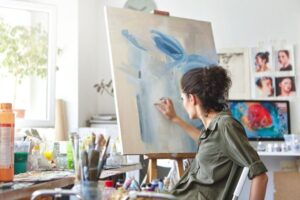Collaboration is a cornerstone of creativity, offering artists the opportunity to share ideas, pool resources, and create something truly unique together. Whether it’s a joint project, a collective exhibition, or a shared creative endeavor, collaborating with other artists can lead to new insights, expanded networks, and enhanced artistic growth. In this blog, we’ll explore the importance of collaboration in the artistic process and share tips for successful collaborations.
Fostering Creativity and Innovation
Collaborating with other artists sparks creativity and fosters innovation. Working with individuals who have different perspectives, skills, and experiences can inspire new ideas and approaches that you might not have considered on your own. The synergy of collaboration often leads to unexpected outcomes and breakthroughs in your artistic practice.
Benefits:
- Generates fresh ideas and perspectives.
- Encourages experimentation and risk-taking.
- Sparks innovation through the exchange of knowledge and techniques.
Building a Supportive Community
Collaboration creates a sense of community and camaraderie among artists. By working together towards a common goal, you forge meaningful connections and establish a support network that can help you navigate the ups and downs of the artistic journey. Collaborators become not only colleagues but also friends and allies in your creative endeavors.
Benefits:
- Provides emotional support and encouragement.
- Offers constructive feedback and mutual learning.
- Fosters a sense of belonging and camaraderie within the artistic community.
Expanding Your Network
Collaborating with other artists introduces you to new audiences and expands your network. Each collaborator brings their own followers, fans, and connections, exposing your work to a wider audience and potentially opening up new opportunities for exposure, exhibitions, and collaborations in the future.
Benefits:
- Increases visibility and exposure for your work.
- Introduces you to new collectors, galleries, and opportunities.
- Facilitates cross-promotion and mutual growth within the artistic community.
Learning and Skill Development
Collaboration provides valuable learning opportunities and facilitates skill development. By working alongside other artists, you can learn new techniques, approaches, and perspectives that can enrich your own practice. Collaborators often bring complementary skills and expertise to the table, allowing you to expand your artistic toolkit.
Benefits:
- Facilitates knowledge sharing and skill exchange.
- Provides opportunities for mentorship and apprenticeship.
- Encourages continuous learning and personal growth as an artist.
Sharing Resources and Reducing Costs
Collaboration allows artists to pool their resources and reduce costs. Whether it’s sharing studio space, materials, or equipment, collaborating with others can make expensive projects more feasible and accessible. By sharing the burden of production, artists can focus more on the creative process and less on logistical challenges.
Benefits:
- Reduces financial burden and overhead costs.
- Enables access to resources and facilities that may be otherwise out of reach.
- Promotes sustainability and resourcefulness in artistic practice.
Tips for Successful Collaborations
1. Define Clear Goals and Expectations:
Clarify the purpose and scope of the collaboration from the outset. Discuss roles, responsibilities, timelines, and desired outcomes to ensure everyone is on the same page.
2. Communicate Openly and Respectfully:
Effective communication is key to a successful collaboration. Maintain open lines of communication, listen to each other’s ideas and feedback, and address any concerns or conflicts proactively.
3. Play to Each Other’s Strengths:
Identify each collaborator’s strengths, skills, and expertise, and leverage them to your advantage. Assign tasks and responsibilities based on individual strengths to maximize efficiency and productivity.
4. Embrace Flexibility and Adaptability:
Be open to compromise and flexible in your approach. Collaborations often require compromise and adaptation as ideas evolve and circumstances change. Embrace experimentation and be willing to pivot if necessary.
5. Celebrate Successes and Learn from Challenges:
Celebrate milestones and achievements along the way, no matter how small. Acknowledge the contributions of each collaborator and celebrate the collective effort. Likewise, view challenges and setbacks as learning opportunities and opportunities for growth.
Conclusion
Collaborating with other artists is a powerful way to enhance creativity, build community, and expand your artistic horizons. By working together towards a common goal, artists can inspire each other, learn from one another, and create something truly extraordinary. Embrace collaboration as a catalyst for growth and innovation in your artistic practice, and enjoy the journey of creating together with fellow artists.




